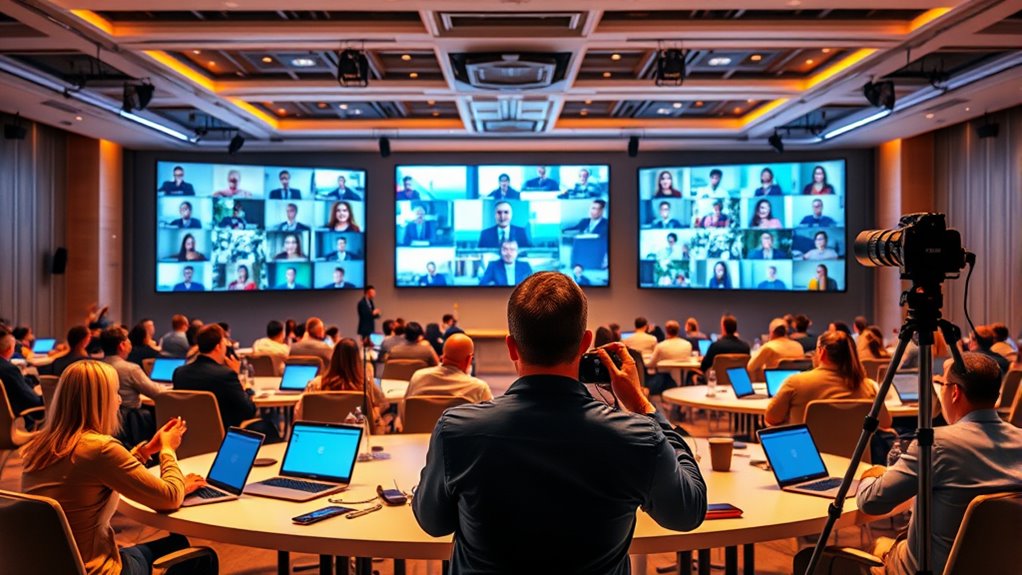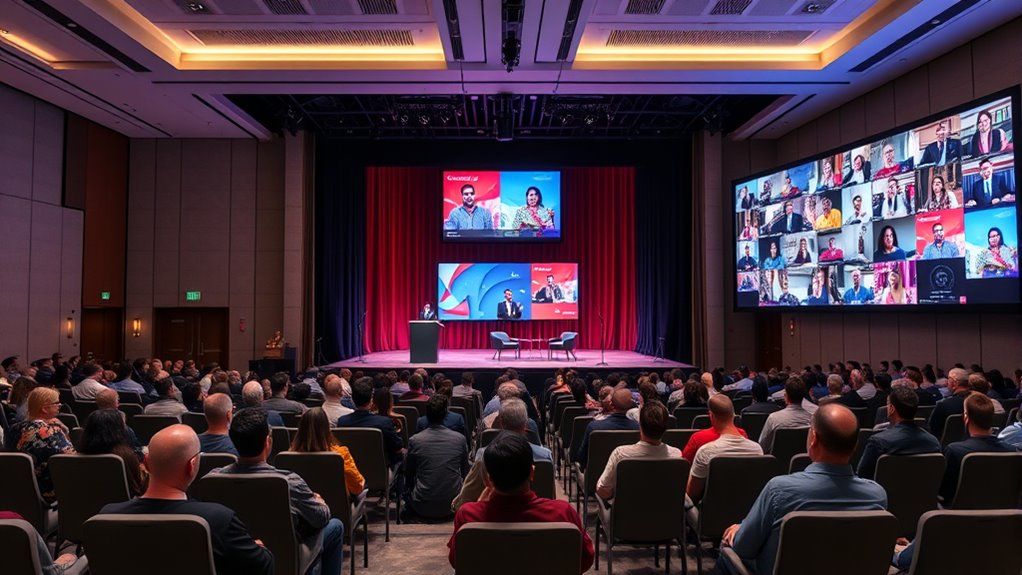Effective hybrid event documentation involves capturing both onsite and virtual components thoroughly. You should record high-quality audiovisual elements, track audience interactions across platforms, and utilize software to analyze engagement and technical performance. Incorporating augmented reality can create immersive experiences and provide deeper insights. By documenting every moment, interaction, and technical detail, you’ll gain valuable perspectives on event success. Exploring this further will give you tools to make your hybrid events even more impactful.
Key Takeaways
- Integrate AR and multimedia tools to capture immersive on-site and virtual experiences seamlessly.
- Track and analyze audience engagement across physical and digital platforms for comprehensive insights.
- Record high-quality audiovisual content and virtual interactions to create complete event archives.
- Use event management software to consolidate data, monitor metrics, and document logistical details.
- Preserve moments, interactions, and analytics to evaluate event success and inform future hybrid strategies.

A hybrid event combines in-person and virtual components, making thorough documentation essential for capturing its full scope. When you’re managing such an event, you need to think beyond traditional notes and recordings. Effective documentation ensures that every moment, interaction, and engagement is preserved, providing valuable insights and a comprehensive record for future reference. One of the key technologies to enhance your documentation efforts is augmented reality. By integrating AR elements, you can create immersive experiences that bridge the physical and digital worlds, making it easier to capture audience engagement from both onsite and remote attendees. For example, AR can offer virtual tours or interactive displays that participants access via their devices, and documenting these interactions becomes vital for analyzing engagement levels and understanding what resonated most. Incorporating interactive techniques can further deepen engagement and improve the quality of your documentation efforts. Audience engagement is the heartbeat of any successful hybrid event. To document this effectively, you need to track participation across all platforms. This involves not only recording attendance numbers but also capturing data on attendee interactions, such as questions asked, polls responded to, or social media activity. Using specialized tools, you can gather real-time analytics that reveal how your audience is engaging with your content, both in the room and online. Incorporate live chat transcripts, virtual Q&A sessions, and social media posts into your documentation process to get a holistic view of engagement. This exhaustive approach helps you identify what worked well and where improvements can be made. Thorough documentation also involves recording the event’s audiovisual components. For on-site elements, this means capturing high-quality video footage, photographs, and audio recordings of key moments, speakers, and panels. For virtual components, you should archive live streams, chat interactions, and shared media. Combining these materials into a unified documentation package creates a full picture of your event. It’s also wise to use event management software that consolidates data from multiple sources, making it easier to analyze engagement metrics and participant reactions afterward. Finally, don’t forget to document logistical details and technical setups. This includes equipment used, connectivity issues, and platform performance. Having this information on hand can guide future event planning, especially as hybrid formats continue to evolve. By maintaining detailed records of both the physical and digital sides of your event, you ensure that you have a complete archive that captures the full experience, making your hybrid events more effective, engaging, and memorable.
Frequently Asked Questions
How Can I Ensure Seamless Integration of On-Site and Virtual Content?
To guarantee seamless integration of on-site and virtual content, focus on interactive streaming and content synchronization. Use reliable platforms that support real-time updates and engagement features. Coordinate with your technical team to test all equipment beforehand, making certain smooth transitions between physical and virtual elements. Keep communication clear among your team, and monitor the stream continuously to address issues promptly, providing attendees with a cohesive, engaging experience.
What Are the Best Tools for Hybrid Event Documentation?
Looking for the best tools for hybrid event documentation? You should consider platforms that offer automated transcription and reliable live streaming capabilities. These tools, like Otter.ai for transcription and Vimeo or YouTube Live for streaming, guarantee your on-site and virtual content is seamlessly captured and shared. Isn’t it vital to choose solutions that simplify your workflow and enhance attendee engagement? By integrating these tools, you create a cohesive, professional event experience.
How Do I Measure the Success of Hybrid Event Coverage?
You measure the success of hybrid event coverage by analyzing engagement metrics like attendance, interaction, and content views across both on-site and virtual platforms. Additionally, gather audience feedback through surveys or social media comments to gain insights into their experience. Tracking these metrics helps you understand what resonated, enabling you to enhance future coverage and guarantee your hybrid event meets your goals effectively.
What Challenges Might Arise in Hybrid Event Documentation?
Like sailing through choppy waters, you might face challenges such as technical glitches and content synchronization issues in hybrid event documentation. Technical glitches can disrupt live streaming, while misaligned content between on-site and virtual elements can confuse your audience. To navigate smoothly, guarantee robust technical support and coordinate content delivery meticulously. Staying prepared for these hurdles helps you deliver a seamless experience, engaging both in-person and virtual attendees effectively.
How Can I Improve Engagement for Virtual Attendees?
You can boost virtual attendee engagement by incorporating interactive polls and live Q&A sessions throughout your event. These features encourage participation, making virtual attendees feel involved and valued. Promote real-time interaction, respond promptly to questions, and use polling results to shape discussions. This active approach keeps virtual attendees engaged, fostering a dynamic, inclusive atmosphere that mirrors on-site experiences and maintains their interest throughout the event.
Conclusion
As you embrace hybrid event documentation, remember you’re crafting a story that bridges worlds—much like the Great Gatsby’s shimmering parties that blend illusion and reality. Your efforts capture moments both seen and unseen, creating a legacy that endures beyond the day. By seamlessly combining on-site and virtual elements, you become the storyteller who unites audiences across distances, ensuring no memory fades into the past. Keep weaving these narratives—your work truly makes history.









